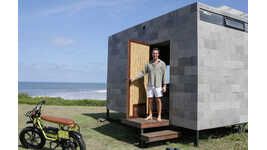Stuart Haygarth's Chandeliers are as powerful to me as any of the environmental artist, Andy Goldsworthy. Goldsworthy makes simple forms from natural material that, often times, have arrived on the shores of our beaches. Stuart Haygarth uses the UN-natural material that arrives on our beaches. And he turns them into lamps with an indescribable luminosity. This work, the Tide Chandelier, brings recycling art to a higher level by making cycles of cycles.
Implications - Consumers are looking for innovative ways to recycle in response to the recent insurgence of environmental studies in mainstream media. By reducing their personal carbon footprints, consumers feel validated from their active involvement in green initiatives. Corporations looking to appeal to environmentally conscious consumers should consider using green initiatives in company operations and products.
Ingenious Use of Recycling
Tide Chandelier by Stuart Haygarth
Trend Themes
1. Recycling Art - Innovative ways of using UN-natural materials for art and lighting with an emphasis on sustainability.
2. Green Initiatives - The implementation of environmentally conscious measures in company operations and products to appeal to environmentally conscious consumers.
3. Carbon Footprint Reduction - Consumers are seeking ways to reduce their carbon footprint through personal initiatives, creating opportunities for companies to develop products and services which aid in this effort.
Industry Implications
1. Art and Design - The use of UN-natural or recycled materials in artistic design as well as their integration into lighting fixtures and installations.
2. Environmental Technology - The development of technology to aid in recycling efforts, carbon footprint reduction, and the implementation of environmentally conscious measures in company operations.
3. Consumer Goods - The incorporation of recycled or sustainable materials in the production of consumer goods to appeal to environmentally conscious consumers.






